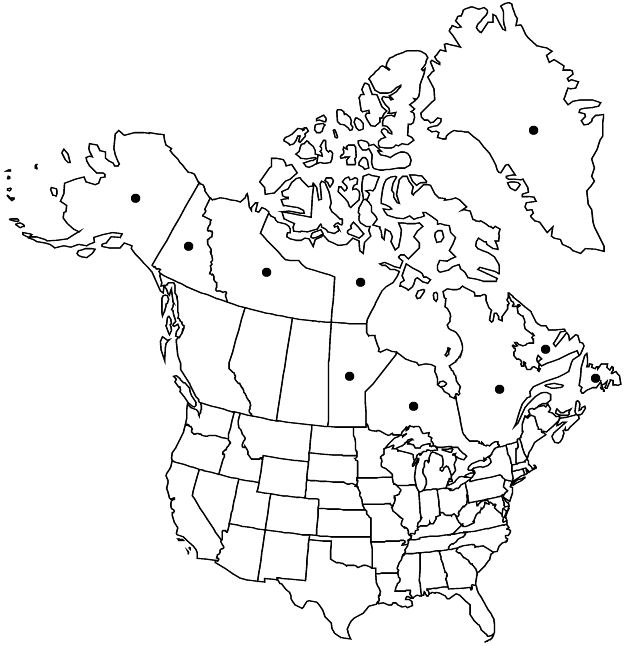Difference between revisions of "Potentilla pulchella"
Chlor. Melvill., 19. 1823.
FNA>Volume Importer |
FNA>Volume Importer |
||
| Line 12: | Line 12: | ||
|name=Potentilla pulchella var. elatior | |name=Potentilla pulchella var. elatior | ||
|authority=Lange | |authority=Lange | ||
| + | |rank=variety | ||
}} {{Treatment/ID/Synonym | }} {{Treatment/ID/Synonym | ||
|name=P. pulchella subsp. gracilicaulis | |name=P. pulchella subsp. gracilicaulis | ||
|authority=(A. E. Porsild) Jurtzev | |authority=(A. E. Porsild) Jurtzev | ||
| + | |rank=subspecies | ||
}} {{Treatment/ID/Synonym | }} {{Treatment/ID/Synonym | ||
|name=P. pulchella var. gracilicaulis | |name=P. pulchella var. gracilicaulis | ||
|authority=A. E. Porsild | |authority=A. E. Porsild | ||
| + | |rank=variety | ||
}} {{Treatment/ID/Synonym | }} {{Treatment/ID/Synonym | ||
|name=P. usticapensis | |name=P. usticapensis | ||
| − | |authority= | + | |authority= |
| + | |rank=species | ||
}} | }} | ||
|hierarchy=Rosaceae;Rosaceae subfam. Rosoideae;Rosaceae tribe Potentilleae;Potentilla;Potentilla sect. Pensylvanicae;Potentilla pulchella | |hierarchy=Rosaceae;Rosaceae subfam. Rosoideae;Rosaceae tribe Potentilleae;Potentilla;Potentilla sect. Pensylvanicae;Potentilla pulchella | ||
| Line 36: | Line 40: | ||
|elevation=0–600 m | |elevation=0–600 m | ||
|distribution=Greenland;Man.;Nfld. and Labr.;N.W.T.;Nunavut;Ont.;Que.;Yukon;Alaska;Eurasia. | |distribution=Greenland;Man.;Nfld. and Labr.;N.W.T.;Nunavut;Ont.;Que.;Yukon;Alaska;Eurasia. | ||
| − | |discussion=<p><i>Potentilla pulchella</i> is morphologically isolated within sect. Pensylvanicae and is very polymorphic. The proposed races (< | + | |discussion=<p><i>Potentilla pulchella</i> is morphologically isolated within sect. Pensylvanicae and is very polymorphic. The proposed races (<i></i>var.<i> elatior</i>, subsp./var. gracilicaulis) differ only in characters appearing throughout the range of the species (more slender and erect to ascending stems, less hairy leaves). Some different morphs are often found close together but in different habitats.</p><!-- |
--><p>Some species with palmate or subpalmate leaves combine features of <i>Potentilla pulchella</i> and species from sect. Niveae (addressed under 8t. sect. Rubricaules); others are possible hybrids between <i>P. hyparctica</i> and <i>P. pulchella</i> (sect. Aureae).</p> | --><p>Some species with palmate or subpalmate leaves combine features of <i>Potentilla pulchella</i> and species from sect. Niveae (addressed under 8t. sect. Rubricaules); others are possible hybrids between <i>P. hyparctica</i> and <i>P. pulchella</i> (sect. Aureae).</p> | ||
|tables= | |tables= | ||
| Line 46: | Line 50: | ||
-->{{#Taxon: | -->{{#Taxon: | ||
name=Potentilla pulchella | name=Potentilla pulchella | ||
| − | |||
|authority=R. Brown | |authority=R. Brown | ||
|rank=species | |rank=species | ||
| Line 61: | Line 64: | ||
|publication year=1823 | |publication year=1823 | ||
|special status= | |special status= | ||
| − | |source xml=https://jpend@bitbucket.org/aafc-mbb/fna-data-curation.git/src/ | + | |source xml=https://jpend@bitbucket.org/aafc-mbb/fna-data-curation.git/src/f50eec43f223ca0e34566be0b046453a0960e173/coarse_grained_fna_xml/V9/V9_326.xml |
|subfamily=Rosaceae subfam. Rosoideae | |subfamily=Rosaceae subfam. Rosoideae | ||
|tribe=Rosaceae tribe Potentilleae | |tribe=Rosaceae tribe Potentilleae | ||
Revision as of 22:40, 16 December 2019
Stems ascending, 0.1–1.5(–2) dm. Basal leaves subpinnate, 1.5–9 cm; petiole 0.7–4 cm, long hairs common to dense, ± appressed to ascending, 0.5–3 mm, soft, short hairs absent, crisped hairs sparse to abundant, glands absent or sparse; leaflets (1–)2(–3) per side, on distal 1/6–1/2 of leaf axis, separate to overlapping, terminal ones oblong or obovate, 0.4–3 × 0.2–1.2 cm, margins revolute, incised 2/3–3/4+ to midvein, undivided medial blade 2–6 mm wide, teeth 2–5 per side, linear to narrowly oblong, surfaces dissimilar, abaxial white, long hairs ± abundant, 1–2 mm, soft, short hairs absent or obscured, crisped and/or cottony hairs dense, glands absent or obscured, adaxial grayish white to dark grayish green, long hairs sparse to dense, loosely appressed to spreading, 0.5–2 mm, short hairs absent, crisped hairs absent or sparse, glands absent. Cauline leaves 1–2. Inflorescences (1–)2–5(–9)-flowered, ± open. Pedicels 0.5–1 cm (proximal to 5 cm). Flowers: epicalyx bractlets oblong to ovate, 2–4(–6) × 0.8–1.3(–2) mm, lengths ± 3/4 times sepals, margins sometimes revolute; hypanthium 2.5–4 mm diam.; sepals 3–5 mm, apex obtuse to subacute, abaxial surfaces: venation indistinct, glands ± abundant, often obscured; petals pale yellow, 4–5 × 2–3 mm, lengths 1.5 times sepals; filaments 1–1.5 mm, anthers 0.4 mm; carpels 30–60, styles papillate-swollen in proximal 1/4–1/3, 0.9–1.2 mm. Achenes 1.4–1.5 mm, smooth or rugose. 2n = 28.
Phenology: Flowering summer.
Habitat: Dry or damp, open tundra, silt flats, stream and seashore banks, bird cliff meadows, fine scree, on loam, clay, or calcareous substrates
Elevation: 0–600 m
Distribution

Greenland, Man., Nfld. and Labr., N.W.T., Nunavut, Ont., Que., Yukon, Alaska, Eurasia.
Discussion
Potentilla pulchella is morphologically isolated within sect. Pensylvanicae and is very polymorphic. The proposed races (var. elatior, subsp./var. gracilicaulis) differ only in characters appearing throughout the range of the species (more slender and erect to ascending stems, less hairy leaves). Some different morphs are often found close together but in different habitats.
Some species with palmate or subpalmate leaves combine features of Potentilla pulchella and species from sect. Niveae (addressed under 8t. sect. Rubricaules); others are possible hybrids between P. hyparctica and P. pulchella (sect. Aureae).
Selected References
None.